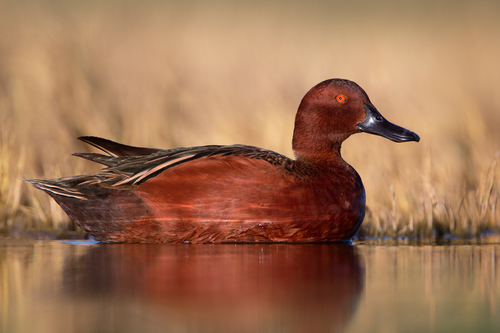
Cinnamon Teal
The Cinnamon Teal (*Spatula cyanoptera*) is a small, vibrantly colored dabbling duck found in the Americas. It is named for the male's rich, cinnamon-red plumage during the breeding season. This species plays a crucial role in wetland ecosystems, primarily consuming plant matter and small invertebrates, thereby influencing vegetation structure and nutrient cycling. It is not considered globally threatened, but some populations face regional pressures.
38-43 cm
Length
56-60 cm
Wingspan
Least Concern
Conservation Status
Distribution
The Cinnamon Teal breeds primarily in western North America, from southern Canada to northern Mexico, and winters in the southern United States, Mexico, and Central America. Some populations are resident in South America, ranging from Colombia to Argentina and Chile.
Lifespan
Average lifespan in the wild is unknown but estimated at 2-3 years; can live longer in captivity.
Cinnamon Teal's Habitat
Habitat Types
Freshwater marshes, Shallow lakes, Ponds, Slow-moving rivers, Coastal wetlands
Climate Zones
Temperate, Subtropical, Tropical
Adaptations
Cinnamon Teals are well-adapted to shallow water environments. They have specialized lamellae (comb-like structures) in their bills, which are used for filtering small food items from the water and mud. They often forage in dense vegetation.
Variations
Five subspecies are recognized, differing primarily in size and slight variations in plumage coloration: *S. c. septentrionalium*, *S. c. tropica*, *S. c. borreroi*, *S. c. orinomus*, and *S. c. cyanoptera*.
Appearance
Breeding Plumage
Breeding males have a bright cinnamon-red head, neck, and underparts, with a brown back and a distinctive blue patch on the upper wing. Non-breeding males (eclipse plumage) resemble females, being mottled brown overall.
Seasonal Feather Changes
Males molt into eclipse plumage after breeding, then back into breeding plumage in the late fall or winter.
Sex Based Plumage Differences
Females are mottled brown year-round, providing camouflage for nesting. They also have the blue wing patch, although it is less vibrant than in males.
Notable Features
Bright cinnamon-red plumage in breeding males, Blue wing patch (speculum), Red eyes in breeding males, Dark bill
Diet and Feeding
Primary Foods
Seeds, Aquatic plants, Insects, Mollusks, Crustaceans
Foraging Behavior
Cinnamon Teals are dabbling ducks, meaning they feed by tipping their bodies forward in the water to reach submerged vegetation and invertebrates. They also skim the water surface and graze on vegetation along shorelines.
Specializations
Their bill lamellae help them filter small food items efficiently.
Seasonal Diet Variations
Diet shifts seasonally based on food availability. During the breeding season, they consume more invertebrates, providing protein for egg production. In the winter, they rely more on seeds and plant matter.
Behavior
Social Structure
Cinnamon Teals are generally gregarious, especially outside the breeding season, forming small flocks. During breeding, they are more territorial.
Communication
Soft quacks by females, Whistles and chattering calls by males, Visual displays during courtship
Migration
Northern populations are migratory, traveling south for the winter. South American populations are largely resident, with some local movements in response to water availability.
Territorial or Group Behaviors
Males defend territories during the breeding season, protecting nesting sites and resources for their mates. Outside of breeding, they are generally non-territorial and form mixed flocks with other duck species.
Conservation
Threats
Habitat loss and degradation (wetland drainage), Agricultural runoff (pesticides and pollutants), Hunting pressure (in some areas), Climate change (altered precipitation patterns)
Protection Programs
North American Waterfowl Management Plan, Wetlands Reserve Program (in the US), Various regional conservation initiatives
Local National Laws
Protected under the Migratory Bird Treaty Act in the US, Canada, and Mexico.
Population Trend
Stable
Population Estimates
Global population estimated at 1.5 - 2.6 million individuals.
Interesting Facts
Cinnamon Teals are closely related to Blue-winged Teals.
They sometimes hybridize where their ranges overlap.
They are one of the smallest dabbling ducks in North America.
Their small size allows them to exploit shallow water habitats that larger ducks cannot access.
They undertake long-distance migrations.
Some individuals travel thousands of miles between their breeding and wintering grounds.
Faqs about Cinnamon Teal
What is the difference between a male and female Cinnamon Teal?
Breeding males have bright cinnamon-red plumage, while females are mottled brown. Both sexes have a blue wing patch.
Where can I see Cinnamon Teals?
Look for them in freshwater marshes, ponds, and shallow lakes, primarily in western North America and parts of South America.
Are Cinnamon Teals endangered?
No, they are classified as Least Concern by the IUCN, meaning their populations are relatively stable.
Copyright @ Nature Style Limited. All Rights Reserved.
 English
English